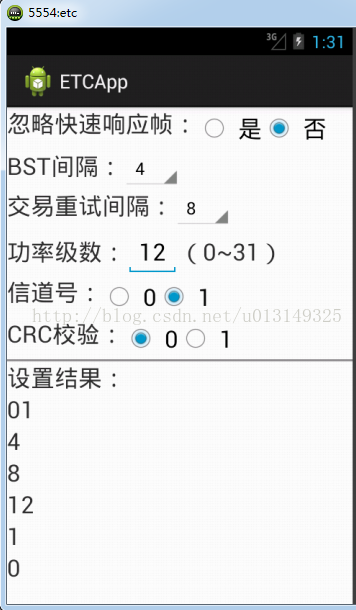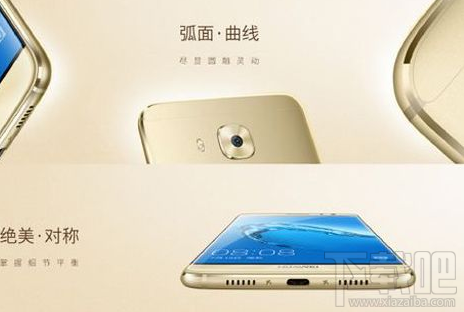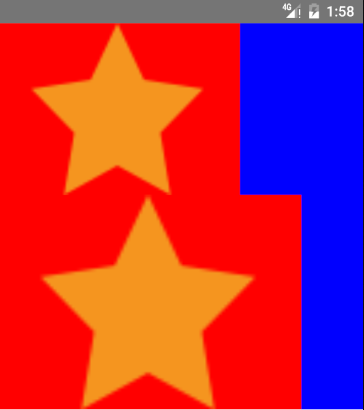編輯:關於Android編程
今天在項目中用到了android中常用的RadioGroup、RadioButton、Spinner、EditText等控件,在此介紹一下它們的用法,希望對需要的朋友有幫助。
一、RadioGroup和RadioButton的使用
RadioButton就是我們常見的單選按鈕,一個RadioGroup可以包含多個單選按鈕,但是每次只能選擇其中的一個值。
我們先看一下布局文件:
再來看一下RadioGroup的監聽器接口:RadioGroup.OnCheckedChangeListener
public interface OnCheckedChangeListener {
/**
*
Called when the checked radio button has changed. When the * selection is cleared, checkedId is -1.
* * @param group the group in which the checked radio button has changed * @param checkedId the unique identifier of the newly checked radio button */ public void onCheckedChanged(RadioGroup group, int checkedId); } 我們需要實現RadioGroup.OnCheckedChangeListener接口,重寫onCheckedChanged(RadioGroup group, int checkedId)函數,參數group指定添加監聽器的RadioGroup,參數checkedId指定選中的RadioButton的ID。
二、Spinner的使用
Spinner是下拉列表選擇框,可以綁定數據源,數據源可以在程序中定義,也可以在values/strings中定義字符串數組,還可以在數據庫中查詢獲取。
布局很簡單,詳見後面的例子。
綁定數據源:
String[] intervalTime = getResources().getStringArray(R.array.intervalTime); ArrayAdapter設置監聽器接口:AdapterView.OnItemSelectedListeneradapter = new ArrayAdapter (this, android.R.layout.simple_spinner_item, intervalTime); bstIntervalSpinner.setAdapter(adapter);
public interface OnItemSelectedListener {
/**
*
Callback method to be invoked when an item in this view has been * selected. This callback is invoked only when the newly selected * position is different from the previously selected position or if * there was no selected item.
* * Impelmenters can call getItemAtPosition(position) if they need to access the * data associated with the selected item. * * @param parent The AdapterView where the selection happened * @param view The view within the AdapterView that was clicked * @param position The position of the view in the adapter * @param id The row id of the item that is selected */ void onItemSelected(AdapterViewparent, View view, int position, long id); /** * Callback method to be invoked when the selection disappears from this * view. The selection can disappear for instance when touch is activated * or when the adapter becomes empty. * * @param parent The AdapterView that now contains no selected item. */ void onNothingSelected(AdapterViewparent); } 我們需要實現AdapterView.OnItemSelectedListener接口,重寫onItemSelected(AdapterViewparent, View view, int position, long id)方法。
三、EditText的使用
EditText很常見,用來輸入文本,給它添加監聽器可以實時監測已經輸入的文本內容,包括查看是否有錯誤、輸入是否符合規范、長度是否超出了范圍。
添加監聽器:
powerEditText.addTextChangedListener(editTextListener);監聽器實現TextWatcher接口:
public interface TextWatcher extends NoCopySpan {
/**
* This method is called to notify you that, within s,
* the count characters beginning at start
* are about to be replaced by new text with length after.
* It is an error to attempt to make changes to s from
* this callback.
*/
public void beforeTextChanged(CharSequence s, int start,
int count, int after);
/**
* This method is called to notify you that, within s,
* the count characters beginning at start
* have just replaced old text that had length before.
* It is an error to attempt to make changes to s from
* this callback.
*/
public void onTextChanged(CharSequence s, int start, int before, int count);
/**
* This method is called to notify you that, somewhere within
* s, the text has been changed.
* It is legitimate to make further changes to s from
* this callback, but be careful not to get yourself into an infinite
* loop, because any changes you make will cause this method to be
* called again recursively.
* (You are not told where the change took place because other
* afterTextChanged() methods may already have made other changes
* and invalidated the offsets. But if you need to know here,
* you can use {@link Spannable#setSpan} in {@link #onTextChanged}
* to mark your place and then look up from here where the span
* ended up.
*/
public void afterTextChanged(Editable s);
}
我們可以根據需要重寫beforeTextChanged(CharSequence s, int start, int count, int after)、onTextChanged(CharSequence s, int start, int before, int count)、afterTextChanged(Editable s)這三個方法。
四、示例和源代碼
先上效果圖:

在上圖中,有3個RadioGroup、2個Spinner和1個EditText,由於程序中設置了監聽器,所以上面選項設置的值都會在分割線下面實時顯示出結果。
源代碼:
布局文件:
Java類文件:
package readAndWriteOBU;
import android.app.Activity;
import android.os.Bundle;
import android.text.Editable;
import android.text.TextWatcher;
import android.view.View;
import android.widget.AdapterView;
import android.widget.ArrayAdapter;
import android.widget.EditText;
import android.widget.RadioButton;
import android.widget.RadioGroup;
import android.widget.Spinner;
import android.widget.TextView;
import com.hustxks.etcapp.R;
public class InitActivity extends Activity{
//忽略快速響應幀單選框
private RadioGroup quickResponseRadioGroup;
private RadioButton yesRadioButton;
private RadioButton noRadioButton;
//BST間隔下拉列表
private Spinner bstIntervalSpinner;
//交易重試間隔下拉列表
private Spinner transIntervalSpinner;
//功率級數編輯框
private EditText powerEditText;
//信道號單選框
private RadioGroup channelNumRadioGroup;
private RadioButton channelRadioButton1;
private RadioButton channelRadioButton2;
//CRC校驗單選框
private RadioGroup crcCkeckRadioGroup;
private RadioButton crcRadioButton1;
private RadioButton crcRadioButton2;
//是否忽略快速響應幀標志:00:忽略快速響應 01:完全透傳
public static String ignoreQuickResFlag = 0;
//BST間隔,單位ms,范圍1~10ms
public static String bstInterval = 10;
//交易重試間隔,單位ms,范圍1~10ms
public static String transRetryInterval = 10;
//功率級數,范圍0~31
public static String power = 5;
//信道號,取值0,1
public static String channelID = 0;
//CRC校驗標志位,取值0,1
public static String crcCheckFlag = 0;
private String[] intervalTime;
//顯示設置結果文本框
TextView resultTextView1;
TextView resultTextView2;
TextView resultTextView3;
TextView resultTextView4;
TextView resultTextView5;
TextView resultTextView6;
@Override
public void onCreate(Bundle savedInstanceState) {
super.onCreate(savedInstanceState);
setContentView(R.layout.init_activity);
initView();
RadioGroupListener quickRadioGroupListener = new RadioGroupListener(quickResponseRadioGroup);
RadioGroupListener channelRadioGroupListener = new RadioGroupListener(channelNumRadioGroup);
RadioGroupListener crcRadioGroupListener = new RadioGroupListener(crcCkeckRadioGroup);
EditTextListener editTextListener = new EditTextListener();
quickResponseRadioGroup.setOnCheckedChangeListener(quickRadioGroupListener);
channelNumRadioGroup.setOnCheckedChangeListener(channelRadioGroupListener);
crcCkeckRadioGroup.setOnCheckedChangeListener(crcRadioGroupListener);
powerEditText.addTextChangedListener(editTextListener);
intervalTime = getResources().getStringArray(R.array.intervalTime);
ArrayAdapter adapter = new ArrayAdapter(this, android.R.layout.simple_spinner_item, intervalTime);
bstIntervalSpinner.setAdapter(adapter);
transIntervalSpinner.setAdapter(adapter);
SpinnerListener bstSpinnerListener = new SpinnerListener(bstIntervalSpinner);
bstIntervalSpinner.setOnItemSelectedListener(bstSpinnerListener);
SpinnerListener retrySpinnerListener = new SpinnerListener(transIntervalSpinner);
transIntervalSpinner.setOnItemSelectedListener(retrySpinnerListener);
}
private void initView() {
quickResponseRadioGroup = (RadioGroup)findViewById(R.id.quickResponseRG);
yesRadioButton = (RadioButton)findViewById(R.id.yesRadioButton);
noRadioButton = (RadioButton)findViewById(R.id.noRadioButton);
bstIntervalSpinner = (Spinner)findViewById(R.id.BSTintervalSpinner);
transIntervalSpinner = (Spinner)findViewById(R.id.transRetrySpinner);
powerEditText = (EditText)findViewById(R.id.powerEditText);
channelNumRadioGroup = (RadioGroup)findViewById(R.id.channelNumRG);
channelRadioButton1 = (RadioButton)findViewById(R.id.channelRadioButton1);
channelRadioButton2 = (RadioButton)findViewById(R.id.channelRadioButton2);
crcCkeckRadioGroup = (RadioGroup)findViewById(R.id.crcCheckRG);
crcRadioButton1 = (RadioButton)findViewById(R.id.crcRadioButton1);
crcRadioButton2 = (RadioButton)findViewById(R.id.crcRadioButton2);
resultTextView1 = (TextView)findViewById(R.id.result1);
resultTextView2 = (TextView)findViewById(R.id.result2);
resultTextView3 = (TextView)findViewById(R.id.result3);
resultTextView4 = (TextView)findViewById(R.id.result4);
resultTextView5 = (TextView)findViewById(R.id.result5);
resultTextView6 = (TextView)findViewById(R.id.result6);
}
//監聽RadioGroup的類
class RadioGroupListener implements RadioGroup.OnCheckedChangeListener {
private RadioGroup myRadioGroup;
public RadioGroupListener(RadioGroup radioGroup) {
// TODO Auto-generated constructor stub
this.myRadioGroup = radioGroup;
}
@Override
public void onCheckedChanged(RadioGroup group, int checkedId) {
// TODO Auto-generated method stub
switch (myRadioGroup.getId()) {
case R.id.quickResponseRG:
if (checkedId == R.id.yesRadioButton) {
ignoreQuickResFlag = 00;
}
else if (checkedId == R.id.noRadioButton) {
ignoreQuickResFlag = 01;
}
resultTextView1.setText(ignoreQuickResFlag);
break;
case R.id.channelNumRG:
if (checkedId == R.id.channelRadioButton1) {
channelID = channelRadioButton1.getText().toString().trim();
}
else if (checkedId == R.id.channelRadioButton2) {
channelID = channelRadioButton2.getText().toString().trim();
}
resultTextView5.setText(channelID);;
break;
case R.id.crcCheckRG:
if (checkedId == R.id.crcRadioButton1) {
crcCheckFlag = crcRadioButton1.getText().toString().trim();
}
else if (checkedId == R.id.crcRadioButton2) {
crcCheckFlag = crcRadioButton2.getText().toString().trim();
}
resultTextView6.setText(crcCheckFlag);
break;
default:
break;
}
}
}
//監聽EditText的類
class EditTextListener implements TextWatcher {
@Override
public void beforeTextChanged(CharSequence s, int start,
int count, int after) {
}
@Override
public void onTextChanged(CharSequence s, int start, int before, int count) {
}
@Override
public void afterTextChanged(Editable s) {
power = powerEditText.getText().toString().trim();
resultTextView4.setText(power);
}
}
//監聽Spinner的類
class SpinnerListener implements AdapterView.OnItemSelectedListener {
private Spinner mySpinner;
public SpinnerListener(Spinner spinner) {
// TODO Auto-generated constructor stub
this.mySpinner = spinner;
}
@Override
public void onItemSelected(AdapterView parent, View view,
int position, long id) {
if (mySpinner.getId() == R.id.BSTintervalSpinner) {
bstInterval = intervalTime[position];
resultTextView2.setText(bstInterval);
}
else if (mySpinner.getId() == R.id.transRetrySpinner) {
transRetryInterval = intervalTime[position];
resultTextView3.setText(transRetryInterval);
}
}
@Override
public void onNothingSelected(AdapterView parent) {
}
}
}
 android JNI的.so庫調用
android JNI的.so庫調用
在一篇博客中看到一篇文章,感覺描述的還可以:在前面的博客中介紹的都是使用java開發Android應用,這篇博客將介紹java通過使用jni調用c語言做開發為了更加形象的
 華為麥芒5高配版怎麼樣 高配版和標配版有什麼區別
華為麥芒5高配版怎麼樣 高配版和標配版有什麼區別
麥芒5的正面仍堅持了大黑邊的設計風格,真的很華為,那麼新款的華為麥芒5標配版和高配版有什麼區別呢?高配版如何?讓我們一起來看看吧!華為麥芒5標配版和高配版區
 Android工程師進階之路 :《Android開發進階:從小工到專家》上市啦!
Android工程師進階之路 :《Android開發進階:從小工到專家》上市啦!
封面 目錄1 目錄2 為什麼寫這本書寫這本書的念頭由來已久了。也許是從我打算寫《Android源碼設計模式解析與實戰》那時起就萌生了這個念頭,因
 React Native等比放大不丟失圖片
React Native等比放大不丟失圖片
大家可以發現, 原生的Image控件無法實現等比放大後無丟失顯示。如: 有一張20x10的圖片, 要放入一個40x30的顯示區域內.1. cover模式(默認),圖片放大